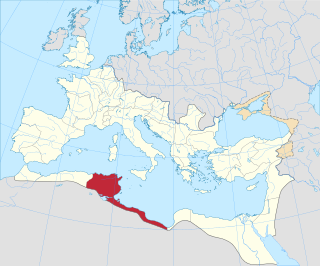
Byzacena was a Late Roman province in the central part of Roman North Africa, which is now roughly Tunisia, split off from Africa Proconsularis.

Aquae in Proconsulari is a former Ancient city and bishopric in Roman Africa and present Latin Catholic titular see.

Vazari-Didda or Vazari Didda) was an Ancient city and bishopric in Roman Africa, which remains a Latin Catholic titular see.

Unizibira was an ancient town and bishopric in Roman North Africa which remains a Latin Catholic titular see.

Henchir-El-Hatba is a village and an archaeological site in Tunisia. It was a Roman Catholic diocese.

Turris in Proconsulari is an ancient settlement of Roman North Africa in the Roman province of Africa Proconsularis. The location is unknown but believed to be in the territory of Henchir-Mest, northern Tunisia.
Ksar-Bou-Saïd is a village in Tunisia on the wadi Oued Bou Saïd south of Tataouine, in the Sahel semi-arid region bordering the Sahara.

Tigias was a Roman-Berber town in the province of Africa Proconsularis in Byzacena. Its stone ruins are located in Henchir-Taus in the oasis of Kriz, Tunisia.

Abidda is the name of an ancient Roman city in the Roman province of Africa proconsularis or in late antiquity in the province of Byzacena. The exact location of the town is not known for certain but it was in northern Tunisia; the ruins at Henchir-Ksour-Abbeda outside of Semta (Dzemda) has been suggested as its location.

Bijga also known as Henchir-Bijga is a place in Tunisia, North Africa, near the city of Tunis.
Canapium was a Roman–Berber town in the province of Africa Proconsolare. Its stone ruins are located near Henchir-El-Casbath, in the region of Mornag, Tunisia.

Carpi was a Roman era, town in the Roman Province of Africa Proconsolare, and has been tentatively identified with ruins at El Mraïssa Henchir-Mraïssa, on Cape Bon in Tunisia.

Simidicca, was a Roman era civitas of the Roman province of ' Africa Proconsolare.

Utimma was an ancient city in the Roman province of Africa Proconsularis during the Byzantine and Roman Empires. the exact location of Utimma is lost to history but it is believed to be between Sidi Medien and Henchir-Reoucha in Tunisia.
Henchir-Mâtria is an archaeological and prehistoric site in northern Tunisia. Henchir-Mâtria is at 36°31′23.4″N9°13′11.1″E, between Béja and Dougga and elevation of 407 metres. It is on the Oued el Beida River.

Gunela was an ancient Roman-Berber town and archaeological site in Bizerte Governorate, Tunisia. It was located at 37.165524n, 9.765536e, within the suburbs of Tinja, Tunisia.

The Diocese of Dices, is a titular see of the Roman Catholic Church. The location of the seat of the diocese is unknown for certain, but is perhaps identifiable with Henchir-Sidi-Salah, Tunisia. Henchir Sidi Salah was an ancient diocese in the Roman-Berber province of Byzacena.

Garriana was a Roman town of the province of Byzacena during late antiquity. The town has tentatively been identified with the ruins at Henchir-El-Garra in modern Tunisia. The name Henchir-El-Garra simply means the Ruins of Garria.

The Diocese of Sassura is a suppressed and titular see of the Roman Catholic Church. The Roman Town of Sassura, identifiable with Henchir-Ez-Zaouadi in today's Tunisia, is the ancient episcopal seat of the diocese which was in the Roman province of Byzacena.
The diocese of Presidio is a suppressed and titular see of the Roman Catholic Church.







